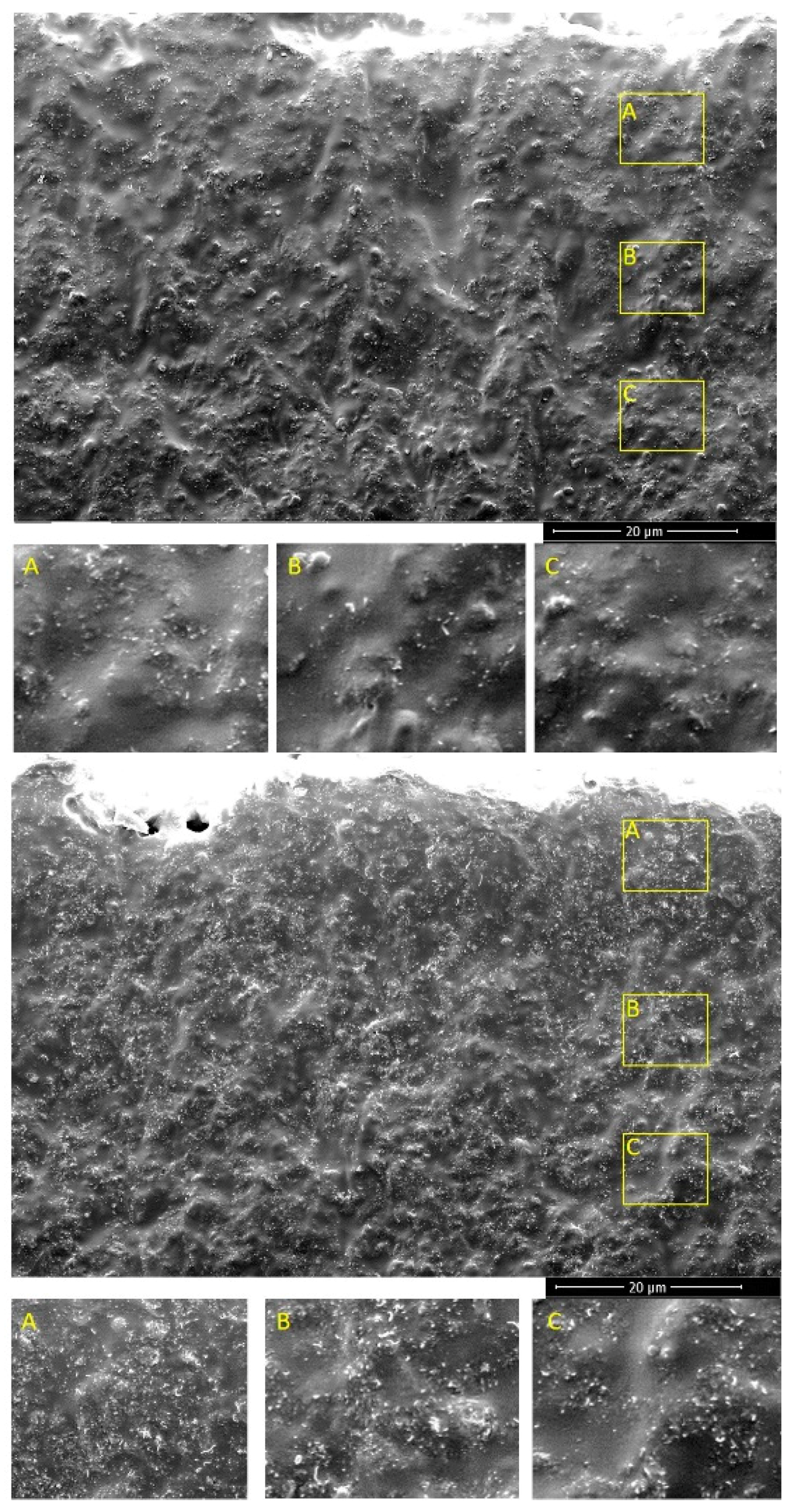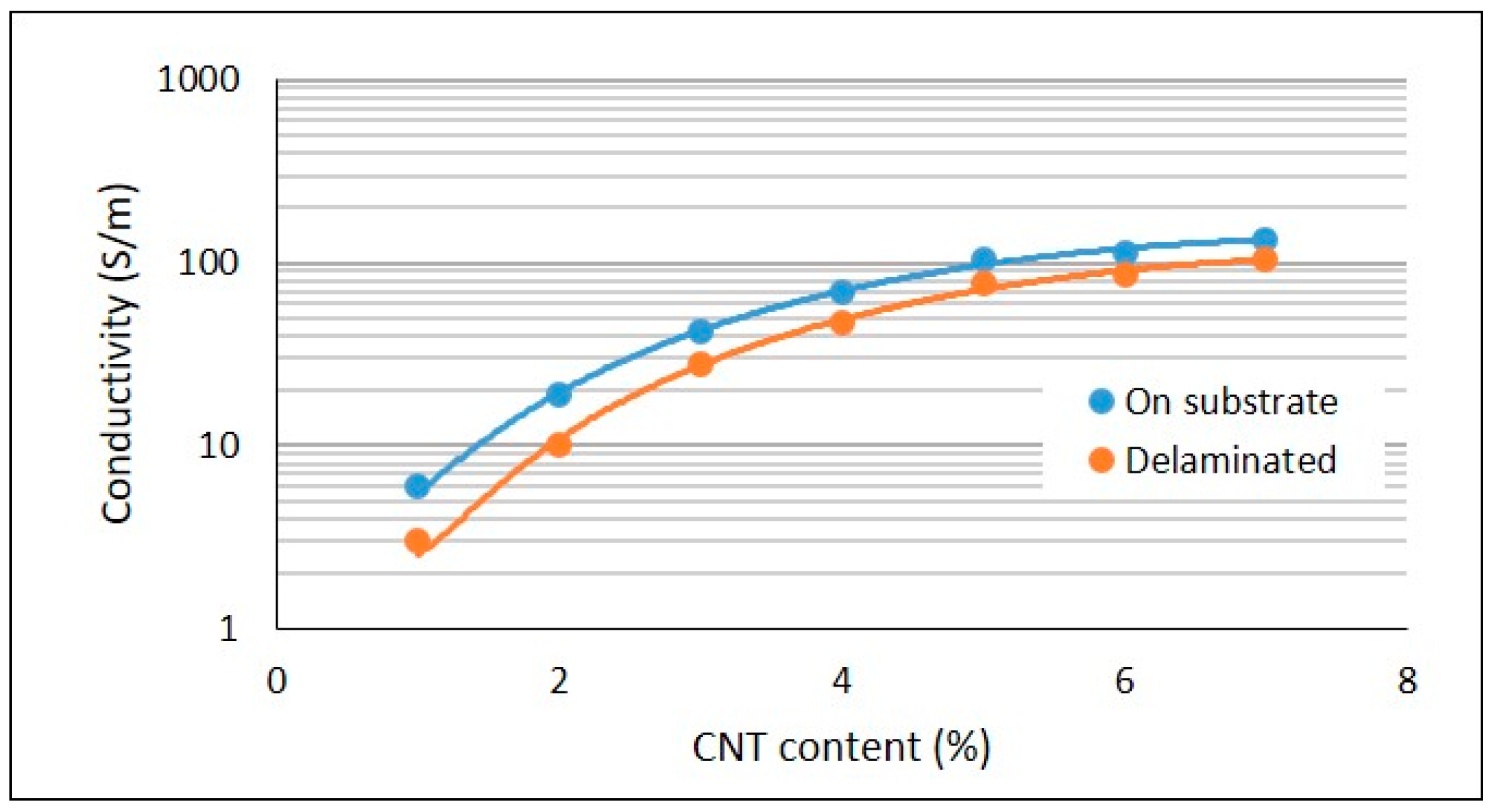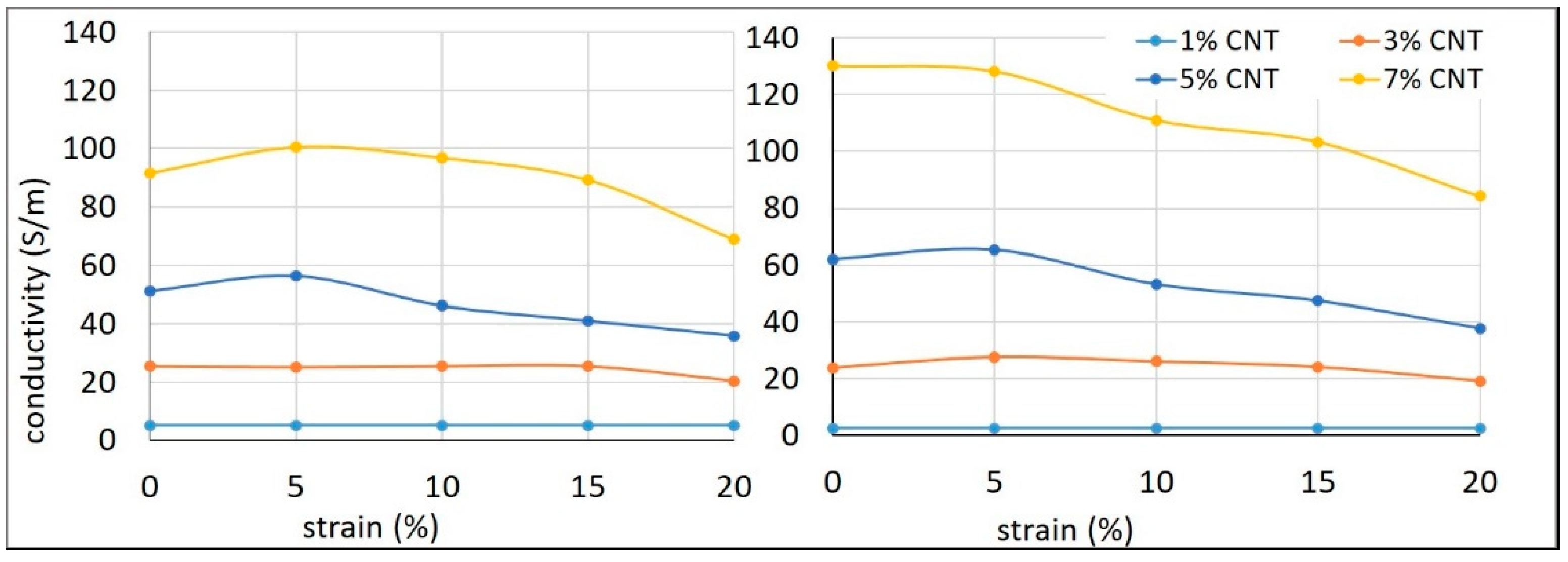Effect of Strain on Heating Characteristics of Silicone/CNT Composites
Abstract
:1. Introduction
2. Materials and Methods
2.1. Chemicals
2.2. Preparation of Silicone/CNT Dispersion
2.3. Preparation of Composite Films
2.4. Application of Contacting Electrodes
2.5. Morphological Characterisation
2.6. Electrical Conductivity Measurements
2.7. Heating Behaviour Measurements
2.8. Heating Behaviour Measurements While Stretching
3. Results and Discussion
3.1. Morphology of Silicone Composites
3.2. Electrical Property of Silicone Composites
3.3. Heating Behaviour
3.4. Heating Behaviour When Uniaxially Strained
4. Conclusions
Author Contributions
Funding
Data Availability Statement
Conflicts of Interest
References
- Mittal, V. Polymer layered silicate nanocomposites: A review. Materials 2009, 2, 992–1057. [Google Scholar] [CrossRef] [Green Version]
- Yu, Y.-Y.; Chen, C.-Y.; Chen, W.-C. Synthesis and characterization of organic–inorganic hybrid thin films from poly (acrylic) and monodispersed colloidal silica. Polymer 2003, 44, 593–601. [Google Scholar] [CrossRef]
- Kim, I.-H.; Jeong, Y.G. Polylactide/exfoliated graphite nanocomposites with enhanced thermal stability, mechanical modulus, and electrical conductivity. J. Polym. Sci. Part B Polym. Phys. 2010, 48, 850–858. [Google Scholar] [CrossRef]
- Shit, S.C.; Shah, P.M. A review on silicone rubber. Natl. Acad. Sci. Lett. 2013, 36, 355–365. [Google Scholar] [CrossRef]
- Rahimi, A.; Mashak, A. Review on rubbers in medicine: Natural, silicone and polyurethane rubbers. Plast. Rubber Compos. 2013, 42, 223–230. [Google Scholar] [CrossRef]
- Hamdani, S.; Longuet, C.; Perrin, D.; Lopez-Cuesta, J.M.; Ganachaud, F. Flame retardancy of silicone-based materials. Polym. Degrad. Stab. 2009, 94, 465–495. [Google Scholar] [CrossRef]
- Lucas, P.; Robin, J.-J. Silicone-based polymer blends: An overview of the materials and processes. Funct. Mater. Biomater. 2007, 209, 111–147. [Google Scholar]
- Yoshimura, K.; Nakano, K.; Hishikawa, Y. Flexible tactile sensor materials based on carbon microcoil/silicone-rubber porous composites. Compos. Sci. Technol. 2016, 123, 241–249. [Google Scholar] [CrossRef]
- Varga, Z.; Filipcsei, G.; Zrínyi, M. Magnetic field sensitive functional elastomers with tuneable elastic modulus. Polymer 2006, 47, 227–233. [Google Scholar] [CrossRef]
- Park, E.-S. Mechanical properties and processibilty of glass-fiber-, wollastonite-, and fluoro-rubber-reinforced silicone rubber composites. J. Appl. Polym. Sci. 2007, 105, 460–468. [Google Scholar] [CrossRef]
- Chen, L.; Lu, L.; Wu, D.; Chen, G. Silicone rubber/graphite nanosheet electrically conducting nanocomposite with a low percolation threshold. Polym. Compos. 2007, 28, 493–498. [Google Scholar] [CrossRef]
- Ding, T.; Wang, L.; Wang, P. Changes in electrical resistance of carbon-black-filled silicone rubber composite during compression. J. Polym. Sci. Part B Polym. Phys. 2007, 45, 2700–2706. [Google Scholar] [CrossRef]
- Kim, H.I.; Wang, M.; Lee, S.K.; Kang, J.; Nam, J.D.; Ci, L.; Suhr, J. Tensile properties of millimeter-long multi-walled carbon nanotubes. Sci. Rep. 2017, 7, 9512. [Google Scholar] [CrossRef] [PubMed]
- Vast, L.; Mekhalif, Z.; Fonseca, A.; Nagy, J.B.; Delhalle, J. Preparation and electrical characterization of a silicone elastomer composite charged with multi-wall carbon nanotubes functionalized with 7-octenyltrichlorosilane. Compos. Sci. Technol. 2007, 67, 880–889. [Google Scholar] [CrossRef]
- Witt, N.; Tang, Y.; Ye, L.; Fang, L. Silicone rubber nanocomposites containing a small amount of hybrid fillers with enhanced electrical sensitivity. Mater. Des. 2013, 45, 548–554. [Google Scholar] [CrossRef]
- Shi, X.; Jiang, B.; Wang, J.; Yang, Y. Influence of wall number and surface functionalization of carbon nanotubes on their antioxidant behavior in high density polyethylene. Carbon 2012, 50, 1005–1013. [Google Scholar] [CrossRef]
- Yamane, S.; Ata, S.; Chen, L.; Sato, H.; Yamada, T.; Hata, K.; Mizukado, J. Experimental analysis of stabilizing effects of carbon nanotubes (CNTs) on thermal oxidation of poly (ethylene glycol)–CNT composites. Chem. Phys. Lett. 2017, 670, 32–36. [Google Scholar] [CrossRef]
- Ata, S.; Hayashi, Y.; Thi, T.B.N.; Tomonoh, S.; Kawauchi, S.; Yamada, T.; Hata, K. Improving thermal durability and mechanical properties of poly (ether ether ketone) with single-walled carbon nanotubes. Polymer 2019, 176, 60–65. [Google Scholar] [CrossRef]
- Moniruzzaman, M.; Winey, K.I. Polymer nanocomposites containing carbon nanotubes. Macromolecules 2006, 39, 5194–5205. [Google Scholar] [CrossRef]
- Bauhofer, W.; Kovacs, J.Z. A review and analysis of electrical percolation in carbon nanotube polymer composites. Compos. Sci. Technol. 2009, 69, 1486–1498. [Google Scholar] [CrossRef]
- Bokobza, L. Enhanced electrical and mechanical properties of multiwall carbon nanotube rubber composites. Polym. Adv. Technol. 2012, 23, 1543–1549. [Google Scholar] [CrossRef]
- Wang, L.; Wang, X.; Li, Y. Relation between repeated uniaxial compressive pressure and electrical resistance of carbon nanotube filled silicone rubber composite. Compos. Part A Appl. Sci. Manuf. 2012, 43, 268–274. [Google Scholar] [CrossRef]
- Chu, K.; Park, S.-H. Electrical heating behavior of flexible carbon nanotube composites with different aspect ratios. J. Ind. Eng. Chem. 2016, 35, 195–198. [Google Scholar] [CrossRef]
- Chu, K.; Yun, D.-J.; Kim, D.; Park, H.; Park, S.-H. Study of electric heating effects on carbon nanotube polymer composites. Org. Electron. 2014, 15, 2734–2741. [Google Scholar] [CrossRef]
- Yan, J.; Jeong, Y.G. Synergistic effect of hybrid carbon fillers on electric heating behavior of flexible polydimethylsiloxane-based composite films. Compos. Sci. Technol. 2015, 106, 134–140. [Google Scholar] [CrossRef]
- Chu, K.; Kim, D.; Sohn, Y.; Lee, S.; Moon, C.; Park, S. Electrical and thermal properties of carbon-nanotube composite for flexible electric heating-unit applications. IEEE Electron Device Lett. 2013, 34, 668–670. [Google Scholar] [CrossRef]
- Trommer, K.; Morgenstern, B.; Petzold, C. Preparing of Heatable, CNT-Functionalized Polymer Membranes for Application in Textile Composites. Mater. Sci. Forum 2015, 825, 67–74. [Google Scholar] [CrossRef]
- Kumar, V.; Lee, G.; Choi, J.; Lee, D.-J. Studies on composites based on HTV and RTV silicone rubber and carbon nanotubes for sensors and actuators. Polymer 2020, 190, 122221. [Google Scholar] [CrossRef]
- Kutějová, L.; Vilčáková, J.; Moučka, R.; Natalia, E.; Babayan, V. A solvent dispersion method for the preparation of silicone composites filled with carbon nanotubes. Chem. Listy 2014, 108, 78–85. [Google Scholar]
- Moseenkov, S.I.; Zavorin, A.V.; Ishchenko, A.V.; Serkova, A.N.; Selyutin, A.G.; Kuznetsov, V.L. Using Current-Voltage Characteristics to Control the Structure of Contacts in Polyethylene Based Composites Modified by Multiwalled Carbon Nanotubes. J. Struct. Chem. 2020, 61, 628–639. [Google Scholar] [CrossRef]
- Wang, P.; Peng, Z.; Li, M.; Wang, Y. Stretchable Transparent conductive films from long carbon nanotube metals. Small 2018, 14, 1802625. [Google Scholar] [CrossRef] [PubMed]
- Zeng, Y.; Liu, H.; Chen, J.; Ge, H. Effect of strain on the electrical resistance of carbon nanotube/silicone rubber composites. J. Wuhan Univ. Technol. Mater. Sci. 2011, 26, 812–816. [Google Scholar] [CrossRef]







| Sequence | 1st Gap (µm) | 2nd Gap (µm) |
|---|---|---|
| 1st pass | 150 | 50 |
| 2nd pass | 40 | 20 |
| 3rd pass | 15 | 10 |
| 4th pass | 5 | 5 |
Publisher’s Note: MDPI stays neutral with regard to jurisdictional claims in published maps and institutional affiliations. |
© 2021 by the authors. Licensee MDPI, Basel, Switzerland. This article is an open access article distributed under the terms and conditions of the Creative Commons Attribution (CC BY) license (https://creativecommons.org/licenses/by/4.0/).
Share and Cite
Gnanaseelan, M.; Trommer, K.; Gude, M.; Stanik, R.; Przybyszewski, B.; Kozera, R.; Boczkowska, A. Effect of Strain on Heating Characteristics of Silicone/CNT Composites. Materials 2021, 14, 4528. https://doi.org/10.3390/ma14164528
Gnanaseelan M, Trommer K, Gude M, Stanik R, Przybyszewski B, Kozera R, Boczkowska A. Effect of Strain on Heating Characteristics of Silicone/CNT Composites. Materials. 2021; 14(16):4528. https://doi.org/10.3390/ma14164528
Chicago/Turabian StyleGnanaseelan, Minoj, Kristin Trommer, Maik Gude, Rafal Stanik, Bartlomiej Przybyszewski, Rafal Kozera, and Anna Boczkowska. 2021. "Effect of Strain on Heating Characteristics of Silicone/CNT Composites" Materials 14, no. 16: 4528. https://doi.org/10.3390/ma14164528
APA StyleGnanaseelan, M., Trommer, K., Gude, M., Stanik, R., Przybyszewski, B., Kozera, R., & Boczkowska, A. (2021). Effect of Strain on Heating Characteristics of Silicone/CNT Composites. Materials, 14(16), 4528. https://doi.org/10.3390/ma14164528









